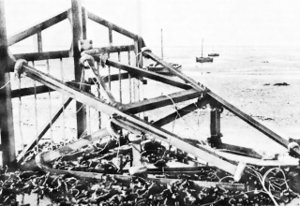- Cointet-element
-
The Cointet-element, also known as a Belgian Gate or C-element, was a heavy steel fence of about three metres wide and two metres high, typically mounted on rollers, was found on D-Day used to keep incoming tanks from getting by, and used as an anti-tank obstacle.
The Cointet-element was the main barricade element of the Belgian KW-line, a tank barricade that was built between September 1939 and May 1940. A total volume of 77,000 pieces was ordered by the Belgian Ministry of Defence and produced by 28 Belgian companies. A large number were installed on the KW-line between the village Koningshooikt and city Wavre to act as the main line of defence against a possible German armoured invasion through the heartland of Belgium. The Cointet-elements were placed next to each other in a zigzag-line and connected with steel cables. Near main roads they were fixed to heavy concrete pillars that were fixed into the ground. In May 1940, due to a relocation programme, the elements didn't form a continuous line and thus were easily by-passed by 3rd Panzer Division and 4th Panzer Division.
After the German victory in Belgium on 28 May 1940, the Belgian Gates were reallocated across Europe to serve as German barricade elements on roads, bridges and beaches. The Germans gave it the name C-element.
Mostly used in and around Belgium after their capture by the German military, the Allies would have great difficulty passing them in the later years of the war.
The gate illustrated has been rigged with explosive "sausages" for demolition using a technique described in the article on UDT.
Categories:- Fortification
- World War II stubs
Wikimedia Foundation. 2010.

